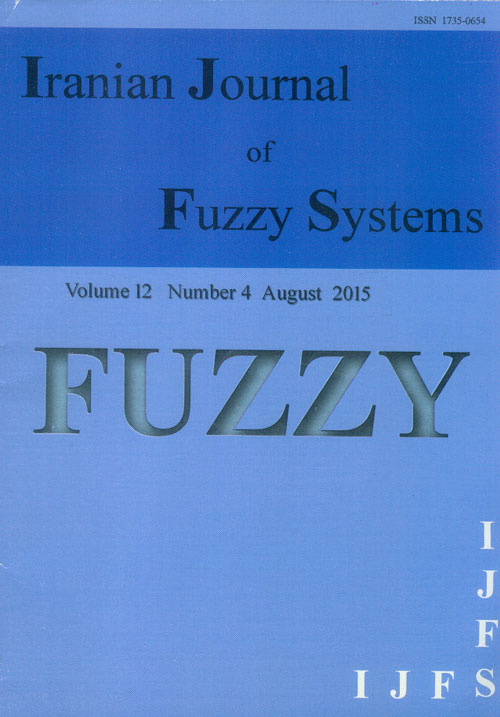فهرست مطالب

Iranian journal of fuzzy systems
Volume:12 Issue: 4, Aug 2015
- تاریخ انتشار: 1394/06/28
- تعداد عناوین: 8
-
-
Pages 1-32In some multi-attribute decision making (MADM) problems, various relationships among the decision attributes should be considered. This paper investigates the prioritization relationship of attributes in MADM with trapezoidal intuitionistic fuzzy numbers (TrIFNs). TrIFNs are a special intuitionistic fuzzy set on a real number set and have the better capability to model ill-known quantities. Firstly, the weighted possibility means of membership and non-membership functions for TrIFNs are defined. Hereby, a new lexicographic ranking method for TrIFNs is presented. Then, a series of trapezoidal intuitionistic fuzzy prioritized aggregation operators are developed, including the trapezoidal intuitionistic fuzzy prioritized score (TrIFPS) operator, trapezoidal intuitionistic fuzzy prioritized weighted average (TrIFPWA) operator, trapezoidal intuitionistic fuzzy prioritized “and” (TrIFP-AND) operator and trapezoidal intuitionistic fuzzy prioritized “or” (TrIFP-OR) operator. Some desirable properties of these operators are also discussed. By utilizing the TrIFPWA operator, the attribute values of alternatives are integrated into the overall ones, which are used to rank the alternatives. Thus, a new method is proposed for solving the prioritized MADM problems with TrIFNs. Finally, the applicability of the proposed method is illustrated with a supply chain collaboration example.Keywords: Multi, attribute decision making, Trapezoidal intuitionistic fuzzy number, Prioritized aggregation operators, Weighted possibility mean
-
Pages 33-57In this research, we address the application of uncertainty programming to design a multi-site, multi-product, multi-period, closed-loop supply chain (CLSC) network. In order to make the results of this article more realistic, a CLSC for a case study in the iron and steel industry has been explored. The presented supply chain covers three objective functions: maximization of profit, minimization of new product's delivery time, collection time and disposal time of used products, and maximizing flexibility. To solve the proposed model, an interactive hybrid solution methodology is adopted through combining a hybrid fuzzy-stochastic programming method and a fuzzy multi-objective approach. Finally, the numerical experiments are given to demonstrate the significance of the proposed model and the solution approach.Keywords: Closed, loop supply chain network design, Multi, objective decision making, Fuzzy mathematical programming, Stochastic programming
-
Pages 59-77In some quality control applications, the quality of a process or a product is described by the relationship between a response variable and one or more explanatory variables, called a profile. Moreover, in most practical applications, the qualitative characteristic of a product/service is vague, uncertain and linguistic and cannot be precisely stated. The purpose of this paper is to propose a method for monitoring simple linear profiles with a fuzzy and ambiguous response. To this end, fuzzy EWMA and fuzzy Hotelling's $T^2$ statistics are developed using the extension principle. To monitor phase II of fuzzy linear profiles, two methods using fuzzy hypothesis testing, are presented based on these statistics. A case study in ceramic and tile industry, is provided. A simulation study to evaluate the performance of the proposed methods in terms of average run length (ARL) criterion showed that the proposed methods are very efficient in detecting various sized shifts in process profiles.Keywords: Fuzzy qualitative profiles, Fuzzy EWMA statistic, Fuzzy Hotelling's $T^2$ statistic, Fuzzy hypothesis testing, ARL criterion
-
Pages 79-100This study presents the effects of project uncertainties on nonlinear time-cost tradeoff (TCT) profile of real life engineering projects by the fusion of fuzzy logic and artificial neural network (ANN) models with hybrid meta-heuristic (HMH) technique, abridged as Fuzzy-ANN-HMH. Nonlinear time-cost relationship of project activities is dealt with ANN models. ANN models are then integrated with HMH technique to search for Pareto-optimal nonlinear TCT profile. HMH technique incorporates simulated annealing in the selection process of multiobjective genetic algorithm. Moreover, in real life engineering projects, uncertainties like management experience, labor skills, and weather conditions are commonly involved, which affect the duration and cost of the project activities. Fuzzy-ANN-HMH analyses responsiveness of nonlinear TCT profile with respect to these uncertainties. A comparison of Fuzzy-ANN-HMH is made with another method in literature to solve nonlinear TCT problem and the superiority of Fuzzy-ANN-HMH is demonstrated by results. The study gives project planners to carry out the best plan that optimizes time and cost to complete a project under uncertain environment.Keywords: Fuzzy logic, Artificial Neural Network, Hybrid Meta, Heuristic, Time, Cost Tradeoff
-
Pages 101-121We study three kinds of compactness in some variants of G"{o}del logic: compactness, entailment compactness, and approximate entailment compactness. For countable first-order underlying language we use the Henkin construction to prove the compactness property of extensions of first-order g logic enriched by nullary connective or the Baaz's projection connective. In the case of uncountable first-order language we use the ultraproduct method to derive the compactness theorem.Keywords: G{o}del logic, Compactness theorem
-
Pages 123-132We study different completeness definitions for two categories of lattice-valued Cauchy spaces and the relations between these definitions. We also show the equivalence of a so-called completion axiom and the existence of a completion.Keywords: $L$, topology, $L$, Cauchy space, Completeness, Completion
-
Pages 133-146Generalized Geraghty type fuzzy mappings on complete metric spaces are introduced and a fixed point theorem that generalizes some recent comparable results for fuzzy mappings in contemporary literature is obtained. Example is provided to show the validity of obtained results over comparable classical results for fuzzy mappings in fixed point theory. As an application, existence of coincidence fuzzy points and common fixed fuzzy points for hybrid pair of single valued self mapping and a fuzzy mapping is also established.Keywords: Fixed fuzzy point, Geraghty type, Fuzzy mapping, Fuzzy set, Approximate quantity
-
Pages 147-153We consider the concept of fuzzy quasi-contractions initiated by '{C}iri'{c} in the setting of fuzzy metric spaces and establish fixed point theorems for quasi-contractive mappings and for fuzzy $mathcal{H}$-contractive mappings on M-complete fuzzy metric spaces in the sense of George and Veeramani.The results are illustrated by a representative example.Keywords: Fuzzy metric space, Fuzzy quasi, contractive mapping, Fixed point

